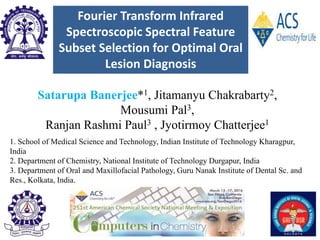Fourier Transform Infrared Spectroscopic Spectral Feature Subset Selection for Optimal Oral Lesion Diagnosis
- 1. Fourier Transform Infrared Spectroscopic Spectral Feature Subset Selection for Optimal Oral Lesion Diagnosis Satarupa Banerjee*1, Jitamanyu Chakrabarty2, Mousumi Pal3, Ranjan Rashmi Paul3 , Jyotirmoy Chatterjee1 1. School of Medical Science and Technology, Indian Institute of Technology Kharagpur, India 2. Department of Chemistry, National Institute of Technology Durgapur, India 3. Department of Oral and Maxillofacial Pathology, Guru Nanak Institute of Dental Sc. and Res., Kolkata, India.
- 2. ŌĆó Background ŌĆó Motivation ŌĆó Methodology ŌĆó Result ŌĆó Take Home Message Content
- 3. Oral Submucous Fibrosis/ OSF Normal/NOM Oral Squamous Cell Carcinoma/ OSCC Different Grades of Oral Epithelial Dysplasia Oral Leukoplakia/OLK Different Types of Pre -Cancer Oral Cancer, Precancer and Carcinogenesis
- 4. Incidence of OSCC Mortality due to OSCC Worldwide prevalence of OSCC Worldwide Incidence, Prevalence and Mortality of OSCC Featured prediction of OSCC in 2035
- 5. ŌĆó Histopathological assessment suffers from inter and intra observer variability (Kujan et al. 2007), 48-72 hours of processing time ŌĆó Utilization of multiple molecular biomarker in disease diagnosis is costly affair ŌĆó Early confirmative diagnosis is needed ŌĆó During conventional FTIR data analysis by PCA ŌĆōLDA based classification, existence of individual feature is lost (Banerjee et al. 2015, 2016) Global Challenge Proposed Solution ŌĆó Exploration of FTIR based spectral marker selection, since Raman spectroscopy can not be implemented in clinical setup due to high data acquisition time, low efficiency of inelastic light scattering (Baker et al. 2014) ŌĆó Feasibility study to assess role of forward feature selection in label free spectral marker identification
- 6. Methodology Formalin fixed paraffin embedded tissue sections 57 tissue biopsy samples (7 NOM, 11 OSF, 16 OLK and 23 OSCC) FTIR Spectra acquisition of deparaffinized acetone dried sections Histopathological validation of H&E tissue sections Feature Selection Forward Feature Selection Two Class Classification by linear SVM, using LOOCV Wrapper Dimensionality Reduction Pre-processing PCA-LDA 6 Best Feature Subset Performance assessment using Sensitivity and Specificity ’üČ Softwares Used ŌĆó OMNICŌäó Series Software - Thermo Scientific ŌĆó IRootLab toolbox in MATLAB R2015a ŌĆó Orange 2.7 for Classification Task
- 7. Goal ŌĆó Choose a subset of the complete set of input features which can predict the output with ŌĆō accuracy comparable to the performance of the complete input set ŌĆō with great reduction of the computational cost Procedure Forward Feature Selection (Heuristic, Wrapper based Search)
- 8. (a1) Mean FTIR spectra of whole region (400-4000-1 cm) (a2) Mean spectra of whole region (400-4000-1 cm) after rubberband like base like correction (RBBC) (a3) Mean spectra of fingerprint region after RBBC, maximum vector normalization followed by Savitzki-Golay differentiation of 1st Derivative spectra of NOM, OLK, OSF and OSCC (a4) LDA scores plot of pre-processed spectra after mean centering and PCA-LDA with confidence ellipse representing confidence interval at 95% (a.u ŌĆō arbitrary unit),(b) Second derivative of average FTIR spectra of NOM, OLK, OSF and OSCC Result
- 9. Disease Classification Sensitivity (%) Specificity (%) Accuracy (%) NOM vs. OLK 68.8 78.3 74.4 OSF vs. OSCC 63.64 91.3 82.35 OLK vs. OSCC 86.96 68.75 79.49 OLK vs. OSF 81.82 81.82 81.48 Classification Performance Assessment Selected Biomarker Disease Classification Spectral Marker Selected (in cm-1 ) NOM vs. OLK 1032, 956, 1707, 1639, 1606, and 1565 OSF vs. OSCC 1687, 1619,1531,1481,1384, and 1322 OLK vs. OSCC 1782, 1713, 1665, 1545, 1409, and 1161 OLK vs. OSF 1670,1306,1757,1723,1611, and 1554
- 10. ŌĆó Label free FTIR based spectral markers can delineate oral lesions, mainly OLK and OSF with high sensitivity and specificity ŌĆó Features selected for each type of disease classification can be used for any pattern recognition system ŌĆó Suggested computational technique is capable of theoretically relevant peak picking for optimal classification based subjective oral disease diagnosis ŌĆó Chemical alteration in diseases is mainly due to protein phosphorylation, as evident from the selected spectra ŌĆó Low cost, readily available spectral marker selection technique was proposed Take Home Message
- 11. ŌĆó S Banerjee, S Chatterjee, A Anura, J Chakrabarty, M Pal, B Ghosh, R R Paul, D Sheet, J Chatterjee. ŌĆ£Global Spectral and Local Molecular Connects with Optical Coherence Tomography Features to Classify Oral Lesions towards Unraveling Quantitative Imaging Bio- markersŌĆØ RSC Advances 6.9 (2016): 7511-7520. ŌĆó S Banerjee, M Pal, J Chakrabarty, C Petibois, RR Paul, A Giri, and J Chatterjee. "Fourier- transform-infrared-spectroscopy based spectral-biomarker selection towards optimum diagnostic differentiation of oral leukoplakia and cancer." Analytical and bioanalytical chemistry 407, no. 26 (2015): 7935-7943. ŌĆó S Banerjee and J Chatterjee "Molecular Pathology Signatures in Predicting Malignant Potentiality of Dysplastic Oral Pre-cancers." Springer Science Reviews 3.2 (2015): 127-136. ŌĆó Kujan, Omar, et al. "Why oral histopathology suffers inter-observer variability on grading oral epithelial dysplasia: an attempt to understand the sources of variation." Oral oncology 43.3 (2007): 224-231. ŌĆó Baker, Matthew J., et al. "Using Fourier transform IR spectroscopy to analyze biological materials." Nature protocols 9.8 (2014): 1771-1791. References











